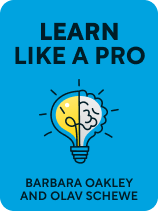

This article is an excerpt from the Shortform book guide to "Learn Like a Pro" by Barbara Oakley and Olav Schewe. Shortform has the world's best summaries and analyses of books you should be reading.
Like this article? Sign up for a free trial here.
What’s the best way to remember what you learn? How can you plan for interruptions when you study? What are some tips for effective note-taking?
Learn Like a Pro: Science-Based Tools to Become Better at Anything by Barbara Oakley and Olav Schewe is a user-friendly guide to improving your approach to learning. Whether you’re a student in school or picking up a new skill, you can become a more effective learner.
Continue reading for an overview of this practical book.
Overview of Learn Like a Pro
Learning can be frustrating. Many people struggle with achieving their learning goals, whether getting good grades in school, passing licensing exams, or mastering new skills. But, in Learn Like a Pro: Science-Based Tools to Become Better at Anything, Oakley and Schewe argue that you can become a better learner if you understand more about how your brain functions and adopt learning methods that work with your brain’s learning capabilities rather than against them.
The authors are confident anyone can improve their learning processes because they themselves once struggled with learning: Both Oakley and Schewe had difficulty getting decent grades in high school. They believed they were born unable to learn certain subjects. However, they each discovered that what was holding them back was their approach to learning, and with some tweaks to their learning processes, they excelled in higher education and became successful in their careers. Oakley is now an engineering professor at Oakland University, and her online courses on improving learning skills have become some of the world’s most popular. She’s also authored and co-authored several books on learning, including Learning How to Learn and A Mind for Numbers. Schewe is the founder and CEO of an education technology company dedicated to developing better learning methods for students and the author of the internationally popular how-to-study guide Super Student.
We’ll outline many of the authors’ learning techniques and explore some of the cognitive psychology and neuroscience of learning so that you can understand why these techniques work. We’ll also examine how you can boost your motivation to learn and provide practical tips for excelling in academic settings so that you can become a better learner for life.
Why Memory Is Essential for Learning
You have two types of memory that work together to help you learn new information and skills—working memory and long-term memory. The authors explain that putting information into your long-term memory is the key to learning, and working memory plays a crucial role in this process.
Long-Term Memory Is the Key to Learning
Full, effective learning happens when information enters and stays in your long-term memory. This happens through neural connections: When you learn something, your neurons connect, forming pathways. When you learn something simple, like memorizing a phone number, those pathways are short. But when you learn something complex, the pathways grow longer and form webs of connections that cement learning into your long-term memory.
The more you use neural pathways, the stronger the bonds between the neurons become, and the better they become a part of your long-term memory. This is why when you practice a skill many times or when you review and recall information often, you’re less likely to forget it. Lots of long and strong pathways in your long-term memory allow you to genuinely understand concepts and easily execute skills.
Working Memory Feeds Long-Term Memory
Before knowledge can enter your long-term memory, it first needs to go through your working memory. Working memory temporarily holds facts, thinks through information, and solves problems. It’s a crucial part of the learning process, but it has limits: Working memory can only hold around three or four thoughts at a time, and if you’re asked to think about more than that, you’ll likely start to forget some of those thoughts.
The authors explain that working memory and long-term memory collaborate in the learning process: The neural links your working memory creates are what eventually enter into your long-term memory once those links have been sufficiently strengthened. Then, those long-term neural links in turn help your working memory operate better: When solving problems or absorbing new information, your working memory reaches into your long-term memory and uses those already established links to connect what you already know with what you’re learning at the moment.
How to Improve Your Working Memory
The authors explain that if you’re struggling to understand the concepts you’re learning, it’s probably because your working memory is overloaded. You can optimize your working memory while learning complex material with the following tips:
- Simplify the information you’re working with: Think of easier words to describe the concept and focus on the main ideas rather than getting lost in the details.
- Start with the basic ideas: Focus on the foundational concepts and gradually add more details and complexity as you get more comfortable with the basics.
- Write things down: As you focus on your learning task, make lists of other ideas and thoughts that come into your mind that you don’t want to forget. Writing down words to jog your memory means your notes can function as your memory instead of your brain.
How to Foster Learning That Lasts
Knowledge moves from your working memory into your long-term memory through one of two ways: either the declarative learning system or the procedural learning system.
The declarative learning system deposits information into your conscious memory so that you’re aware of it and can purposefully recall it. This is how you store information, like facts about a subject you’re learning for a test. With this system, you learn through logical and sequential steps: A + B = C. Once you’ve learned something through the declarative system, your working memory retrieves that information from your long-term memory through the declarative neural pathways.
The procedural system deposits information into your subconscious memory. This is the type of long-term memory you pull from when performing skills you’re so familiar with that they become automatic, and you don’t have to consciously direct them. The procedural system works by instinctively sensing and remembering patterns through repeated exposure to the information or by practicing an action.
You can learn most effectively by tapping both systems. When you first learn something, you use your declarative system to consciously understand a concept or perform an action. Then, with practice, your procedural system builds on that learning and ingrains it into your long-term memory.
Gain Mastery and Fluency With the Procedural System
The authors discuss some techniques that can help you understand concepts deeply enough that they become governed by your procedural system, so you can access that information or skill without consciously thinking about it. Two areas that can benefit from this ability are mathematics and languages.
To comprehend complex mathematical concepts intuitively, you must understand why they work, not just the step-by-step methods of how they work. To achieve that level of mastery, the authors recommend you solve practice problems for which you have access to their step-by-step resolved solutions. Then, try to figure out each step yourself before checking the solution. This will train you to listen to your inner voice—your intuition—about how to approach the problem and will help you internalize the process. Once you’ve internalized it, you’ll be able to tackle other, similar problems because your brain will have learned the patterns behind them.
To learn new languages, you can use both your declarative and procedural systems to help you internalize vocabulary and grammar rules and to achieve fluency (a level of familiarity where you can speak naturally without having to think about it). To support the pattern-finding power of your procedural system, space out your practice sessions—the longer you want to remember, the longer you should pause between review sessions.
How Different Modes of Attention Can Help You Learn
The authors explain that the brain has two modes of attention: focused and diffuse mode. By properly engaging both modes, you can better learn new concepts and skills, understand complex topics, and move past periods when you feel stuck and can’t seem to make progress in your learning.
Focused mode is when you deliberately concentrate on a task in front of you. This mode is best for strengthening your understanding of familiar topics or gaining new knowledge related to things you already know, such as learning new vocabulary in your native language. This is because focused mode uses neural connections that have already been formed in your brain.
Diffuse mode is when you’re not focusing on any one thing in particular but instead are letting thoughts flow through your mind naturally—as happens when you’re going through routine parts of your day like making breakfast or driving to work. As you’re doing these things, your brain works on problems and processes new information “in the background” by making novel connections (building new neural pathways) between ideas and knowledge that it cannot make while in focused mode. These new neural pathways are what integrate new learning into your brain.
To learn something complex, you’ll need to alternate between focused and diffuse modes. When you’re learning something simple, focused mode will be all you need. But when you’re learning something complex, you won’t be able to fully absorb the concepts if you stay in focused mode alone. This is because, in focused mode, your brain suppresses all thoughts except what you’re purposefully paying attention to, which will prevent you from making the “aha” connections between different pieces of information that diffuse mode encourages.
Switch back and forth between both modes to build and strengthen your understanding of new ideas: Work in focused mode until you start to get stuck, then switch to diffuse mode to let your brain work on those ideas in the background. Then switch back to focused mode to continue your learning again.
How to Improve Your Focused Mode
The authors say you can improve the power of your focused mode with the following tips:
Reduce distractions. The authors advise making your environment as distraction-free as possible and minimizing interruptions. Choose a location where socializing doesn’t typically occur, such as a quiet library or private study space. If you can’t avoid noise, consider using noise-canceling headphones or earplugs. Keep your phone out of sight, disable notifications on your electronic devices, or use website blockers to avoid being distracted by social media or other notifications.
Avoid multitasking. The authors advise that you only multitask (switch back and forth between tasks) infrequently. Studies show that constantly switching between tasks harms your ability to concentrate, which makes you more likely to make mistakes and hurts your ability to write and remember information. This is because part of your attention lingers on your previous task—what the authors call attention residue—which prevents you from fully focusing on the new one.
However, task-switching has some benefits: It can foster creative thinking by freeing you from ruts in your thinking that can occur when you concentrate for too long on a single task by changing and expanding your perspective.
Have a plan for interruptions. The authors recommend that, when inevitable interruptions occur, take a moment to note where you will leave off in whatever you are focusing on. This gives your brain a sense of closure that reduces the attention residue of multitasking, therefore helping you regain focus when you return to your learning task. Acknowledge and respond to the interruption, and then make a clean break from the interruption and completely switch your attention back to your learning.
How to Use Diffuse Mode for Learning
Being in diffuse mode might feel unproductive for learning compared to focused mode because it seems like you’re not doing anything. But the authors assert that diffuse mode is essential for learning complex topics or skills and can help you get unstuck when you’re struggling to learn something new.
To take advantage of diffuse mode, the authors advise you to take frequent, five- to 10-minute breaks while learning. The specific technique they recommend to incorporate breaks into your process is the Pomodoro method:
- Remove distractions from your environment, especially easily accessible technology distractions like open computer tabs and cell phones.
- Set a timer for 25 minutes.
- Concentrate as much as you can on your learning task.
- After 25 minutes, take a break for five minutes. The break should be an activity that doesn’t require much concentration, like stretching for a few minutes or petting a pet. Checking emails and social media doesn’t count as a break, as these activities do not put your mind in diffuse mode.
- Repeat the timed work and break cycles as necessary.
Improve Learning by Boosting Motivation and Self-Discipline
Improving your motivation and self-discipline to tackle learning tasks can improve how effectively you learn. Motivation is how much effort you’re willing to put into achieving a goal, and self-discipline, or willpower, is your ability to make small sacrifices now to accomplish that goal in the future. The authors argue that when it comes to your self-discipline for learning, the best approach is not to cultivate more of it but instead to focus on strategies that reduce or eliminate your need to use it in the first place. Boosting your motivation is one of the best ways to bypass the need for self-discipline—when you’re motivated to learn, you don’t need to tap into your willpower to do it.
You may not always feel enthusiastic about your learning tasks, but the authors recommend several ways you can strengthen your motivation for learning and lessen the need to exert self-discipline to accomplish your learning goals.
Set compelling goals. To stay motivated, set three types of goals: long-term goals (like starting your own business), which keep you focused on and excited about the future; stepping-stone goals (like getting your MBA), which are closer in time and help you reach your long-term goal; and process goals, which are short-term and actionable daily and weekly learning tasks (like studying for your MBA exams) that build toward your stepping-stone goal.
Make study plans, and anticipate the obstacles that could deter you. Strategize when, where, and how you’ll study or practice and mark it on your calendar because you’re more likely to follow through on studying if you make a plan. Then, think about what could get in the way of your plan. It’s also helpful to set yourself up for success.
Change your habits. We all have habits and routines, and some may get in the way of our learning. Identify the habits that may make it harder for you to commit to your learning goals and try to change them.
Don’t isolate yourself. Spend time with people interested in and passionate about what you’re learning. Learning with others makes it more enjoyable and fulfilling, which are powerful emotional motivators. Involving others in your learning also helps keep you accountable for your goals—it’s harder to procrastinate, forget, or avoid learning tasks if you have made a commitment to another person.
Match the difficulty level of a task with your skill level. Tasks that are too challenging will discourage you, and ones that are too easy will bore you. The feeling of mastering something—when your skill level matches the difficulty level of a task—is highly motivating. If a task is just beyond your level, don’t be shy to ask for help. The authors also recommend breaking up learning tasks into manageable chunks to allow yourself more time to absorb the information.
How to Excel at Academic Learning
The authors offer tips and techniques for excelling at these key elements of academic learning, including how to actively engage with your materials as well as how to read, take notes, and memorize.
How to Learn Actively With Active Recall
The authors argue that the best way to learn is to actively engage with the material. By doing so, you’ll absorb far more information than when you engage with materials more passively. This is because active learning helps build longer and stronger neural connections.
To actively engage with your materials, they recommend a technique called active recall. To practice active recall, periodically look away from what you’re studying and try to remember what you just learned. It can also be helpful to explain the ideas in your own words or teach them as if you were explaining them to a grade schooler. You can use this technique with any kind of material, such as text, videos, or lectures.
Active recall helps you internalize concepts. The authors say that you haven’t really learned if you can’t retrieve something from your memory, and that when you pull information from your memory, you help solidify it in your long-term memory. Active recall can also give you real-time feedback on how well you’re absorbing new information.
How to Read
Improving reading efficiency is not only about increasing speed. It’s about optimizing your comprehension—understanding what you read and remembering it later. Focusing solely on increasing your reading speed can easily harm your comprehension.
To increase your reading efficiency and comprehension, the authors recommend the following:
Preview the text before reading it in detail. Getting a big-picture view of the text, its organization, and the overall themes will prepare your mind for what is coming and make it easy to comprehend.
Read actively. To read actively, practice active recall by asking yourself to restate key concepts as you read. Highlighting can also help you read actively, but only when you review what you’ve highlighted the next day—your brain doesn’t build neural connections in your long-term memory unless you review your highlights after some time has passed.
Annotate. Another active reading strategy is annotation. As you read, write down comments and questions that come to mind. In your own words, note key concepts and their relationships, and then, in the end, write a small summary of what you read. Annotating as you go makes reviewing and referring back to the text easier. It also helps transfer the information into your long-term memory for quality learning.
How to Take Notes
To get the most out of note-taking, use engaging ways to take them, organize them, review them, and use them as study tools. The authors outline the following strategies to make the most out of your notes.
Take notes with the dual-column method. Divide your note page into two parts with a vertical line down the center. Capture the key concepts on the right side and summarize them on the left using short phrases. When reviewing your notes, cover up the right side and try to recall the meaning from the summary words. This method helps you understand the structure of ideas and retain the information better.
Use mind mapping to organize your notes. Mind maps are visual representations of topics. A typical mind map starts with a central idea or concept and branches into related ideas connected with lines, colors, and images.
Use active recall to review your notes. Review your notes the same day you write them and again the next day. Practice with them using active recall strategies like flashcards. The authors assert that the process of reviewing your notes is more important than the process of note-taking itself.
How to Memorize
To improve your memorization skills, practice active recall and space out your session over several days. Additionally, try memorization hacks such as acronyms and mnemonic devices. You can also envision unusual, vivid, and compelling images to represent concepts and information, such as with the memory palace technique. In this technique, you create a representative image for every idea you want to remember and then “place” those images in a particular space, like a building, in your imagination.
How to Do Well on Tests
No matter how well you know a subject, your test scores will likely suffer if you don’t know how to take a test effectively. The authors offer the following tips.
Before a test: Understand the test format, the types of questions that will be asked, and how the test will be evaluated. Discuss any unclear aspects of the test with your instructor, and talk to peers to gain insights they may have. Create a study plan with a schedule, necessary study materials, and the time you’ll devote to each topic. Having a plan can reduce stress and help you focus on studying.
During a test: Read the instructions carefully and, on timed tests, keep track of your progress. Try to answer all the questions, even if you’re unsure of the answer, unless the test penalizes guessing. Use the challenge-first method: Start by scanning the questions, marking the hard ones, and working on them until you feel stuck. Then, move on to easier problems, and return to the challenging problems later. While working on the easier problems, your brain will work in diffuse mode to sort out the harder problems in the background. Be mindful of your time—don’t get fixated on difficult questions while neglecting easier ones that can also earn you points.

———End of Preview———
Like what you just read? Read the rest of the world's best book summary and analysis of Barbara Oakley and Olav Schewe's "Learn Like a Pro" at Shortform.
Here's what you'll find in our full Learn Like a Pro summary:
- Proven techniques for mastering new skills and knowledge quickly
- How to improve your memory, increase your focus, and manage your time
- Practical tips for how to excel in academic settings






